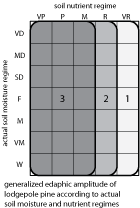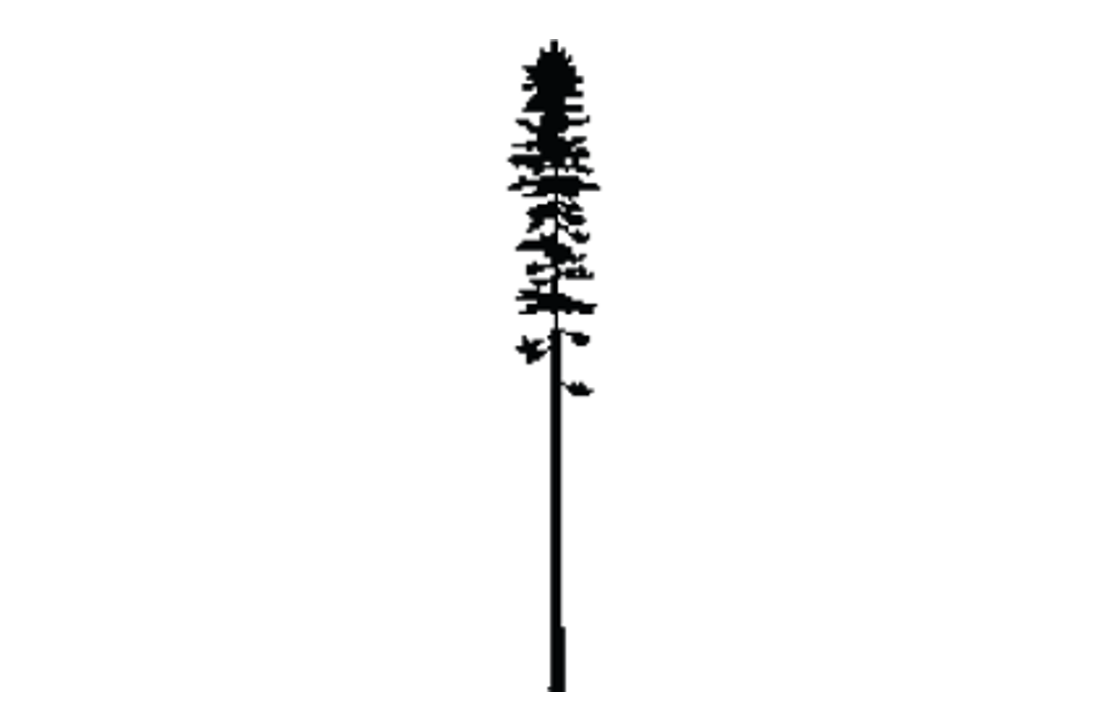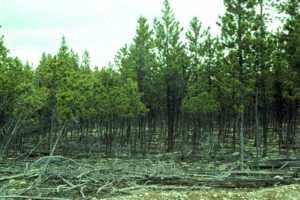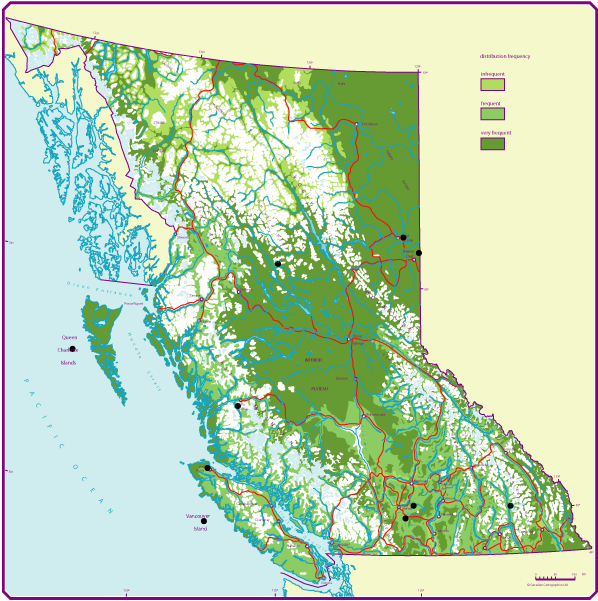Lodgepole pine
Lodgepole pine (Pl) - Pinus contorta
Lodgepole pine is a medium-sized (occasionally >30m tall), evergreen conifer at maturity with a sparse, variable crown, spreading branches, and a thin, orange brown to gray bark, with fine scales – bark is thicker and more grooved on the coast.
It is the most widely distributed pine species in western Canada and an important timber species for pulp, lumber, and a variety of other products.
On this page
- Geographic range and ecological amplitudes
- Tolerances and damaging agents
- Silvical characteristics
- Genetics and notes
Geographic range and ecological amplitudes
Geographic range
Geographic element:
Western North American/Pacific, Cordilleran and marginally Central
Distribution in western North America:
north, central and (south) in the Pacific region; north, central and south in the Cordilleran region
Ecological amplitudes
Climatic amplitude:
continental subalpine boreal - montane boreal - (cool semiarid) - cool temperate - cool mesothermal
Orographic amplitude:
submontane - montane - subalpine
Occurrence in biogeoclimatic zones:
(lower MH), (lower SWB), lower ESSF, MS, BWBS, SBS, SBPS, (PP), IDF, ICH, CDF, CWH
Edaphic amplitude

Range of soil moisture regimes:
very dry - moderately dry - slightly dry - fresh - moist - very moist - wet
Range of soil nutrient regimes:
very poor - poor - medium - rich - (very rich); weakly oxylophytic
In comparison with jack pine, lodgepole pine is easily established in acid mesothermal bogs which do not freeze. On the other hand, lodgepole pine is very infrequent or absent in boreal bogs which freeze every winter. This indicates that the frost resistance of lodgepole pine in more continental climates is lower than that of jack pine, white spruce, black spruce, or tamarack.
Tolerances and damaging agents
Root system characteristics
The root system of lodgepole pine is generally shallow but taproot and vertical sinkers develop on well-drained sites. Roots of lodgepole pine are associated with both ecto- and endo-mycorrhizae.
| Tolerance to | Tolerance class | Comments |
|---|---|---|
| low light | L | slightly shade-tolerant in driest climates |
| frost | H | frequent on sites affected by growing season frost |
| heat | M | frequent on insolated sites |
| water deficit | H | very frequent on the driest sites |
| water surplus | H | tolerates well wet sites and sites with a strongly fluctuating water table |
| nutrient (mainly N) deficiency | H | very frequent on very poor sites |
| Damaging agent | Resistance class | Comments |
|---|---|---|
| snow | L | intolerant of heavy snowpack |
| wind | M | prone to blowdown in dense stands |
| Risk class | ||
|---|---|---|
| fire | H | adapted to regenerate after wildfires |
| insect | H | mountain pine beetle, pine engraver, northern lodgepole pine needleminer, lodgepole pine terminal weevil |
| fungi | H | atropellis canker, comandra blister rust, western gull rust; root and butt rots not a serious concern (e.g., red ring rot and Armillaria root disease) |
| other agents | H | dwarf mistletoe (Arceuthobium americanum Nutt. ex Engelmann) |
Associated tree species and successional role
In British Columbia, lodgepole pine grows predominantly in even-aged, post-fire forests, in pure or, less often, mixed-species stands. It is a pioneer species (primary succession) on rock outcrops and in ombotrophic wetlands, and is present in early, mid-, and late stages of secondary succession on water deficient and waterlogged sites). It is a major component in the hypermaritime forest and fire-disturbed communities in the SBPS zone.
| Associated tree species |
Occurance class | Major area of occurance |
|---|---|---|
| black spruce | H | BWBS. |
| white spruce (and hybrids) | H | montane boreal climates |
| western larch | H | cool temperate climates in southern B.C |
| common douglas | M | cool temperate climates |
| trembling aspen | M | montane boreal and cool temperate climates |
| engelmann spruce | M | ESSF |
| subalpine fir | M | boreal climates |
| western hemlock | L | ICH and hypermaritime CWH |
| western redcedar | L | hypermaritime climates |
| balsam poplar and Black cottonwood | L | montane boreal and cool temperate climates |
| ponderosa pine | L | mainly in southern IDF |
| tamarack | L | BWBS |
| alaska yellow-cedar | L | hypermaritime climates |
| paper birch | L | montane boreal climates |
Genetics and notes
Genetics
Lodgepole pine has evolved several highly differentiated but inter-fertile geographic races that differ morphologically and ecologically: Rocky Mountain-Intermountain, Sierra-Cascade, Coastal, Mendocino White Plains, and Del Norte races.
Lodgepole pine hybridizes with jack pine, producing the hybrid P. x murraybanksiana (see Pinus banksiana). This interspecific breeding is probably of rather recent origin, because it affects populations of lodgepole pine only in certain limited areas. Geographic variation in lodgepole pine was discussed by Critchfield (1957).
Notes
Lodgepole pine is one of the few species with a very wide ecological amplitudes and tolerances. Because it has little taper and thin bark, it produces a higher volume of wood than many of its associates of the same diameter and height. A common problem of regenerating lodgepole pine is overstocking which results in growth stagnation at the early stand developmental stage on water-deficient, nutrient-poor sites. More detailed silvics information is given by:
Baumgartner, D.M., R.G. Krebill, J.T. Arnott, and G.F. Weetman. (compilers and editors) 1985. Lodgepole pine and its management. Washington State University, Pullman, Washington. 381 pp.
Lotan, J.E. and W.B. Critchfield. 1990. Pinus contorta. Pp. 302-315 in R.M. Burns and B.H. Honkala (technical coordinators) Silvics of North America, Vol. 1. Agri. Handbook 654, USDA For. Serv., Washington, D.C.

This is the general shape and outline of the lodgepole pine.

A very high density stand of lodgepole pine developed after fire on water and nutrient deficient fluvial deposits in the Prince George Natural Resources District.

